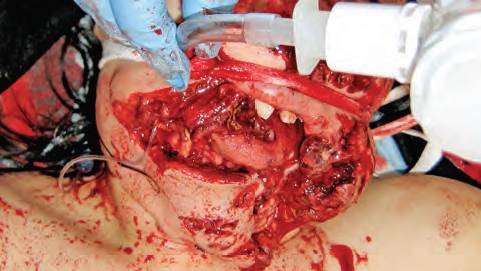
Reconstructive computed tomography can assess the laryngeal framework to avoid missing laryngeal fracture and, hopefully, long-term comorbidities. Non-contrast CT can evaluate the cartilaginous and bony components of the hyoid and larynx. Depending on availability and local expertise, videostroboscopy of the larynx and electromyography of the larynx may be performed by the appropriate consultants.
Explore This Issue
ACEP Now: Vol 42 – No 10 – October 2023For Schaefer type 1 and 2 injuries, close monitoring is recommended, along with intravenous dexamethasone and nebulized steroids. Conservative management entails observation, elevation of the head of the bed, steam inhalation, voice rest, and IV corticosteroids.
If the patient needs surgical exploration, tracheostomy is the recommended intervention to secure the airway. Early exploration and reconstruction of the laryngeal framework is generally recommended to preserve laryngeal function and to restore normal phonation. Surgical exploration and correction of fractures may utilize mini-plates, 3-D plates, bioresorbable plates, Montgomery intralaryngeal stent, thread, steel wires, titanium mesh to fix fractured laryngeal cartilage, or titanium plates.3
The patient was intubated successfully, in the ED under direct vision, as the vocal cords were visible through the wound and the trachea appeared to be intact. An endotracheal tube (ETT) was placed over a bougie. She was transported to the operating suite where a tracheostomy was performed. Significant mucosal lacerations were encountered. The mucosa was repaired to ensure coverage and to prevent scarring. Reduction of laryngeal fractures with fixation was accomplished. A minor esophageal injury was repaired. Soft tissue and skin were repaired last. She was given tube feedings for approximately one week. Major vessels were unharmed per neck CT with contrast. The tracheostomy was kept in place until the larynx was fully healed. She is currently undergoing therapy with a speech pathologist.
While her long-term result is still evolving, it is important to note that complications of laryngeal injuries may be both acute and chronic. Acute complications are upper-airway obstruction and asphyxia. Recurrent nerve injury, hematoma, infection, and death are possible. Chronic complications may cause problems which may cause patients to present to the ED: vocal-cord paralysis; chronic aspiration; recurrent granulation formation; hoarseness; supraglottic, glottic, subglottic, or tracheal stenosis; and recurrent laryngeal nerve dysfunction.
Pages: 1 2 3 4 | Single Page




No Responses to “Laryngeal Injuries: An Introduction”